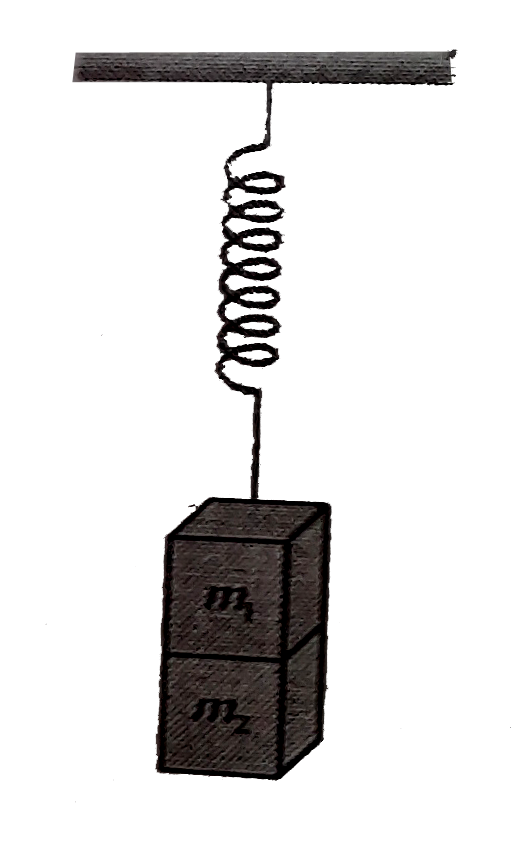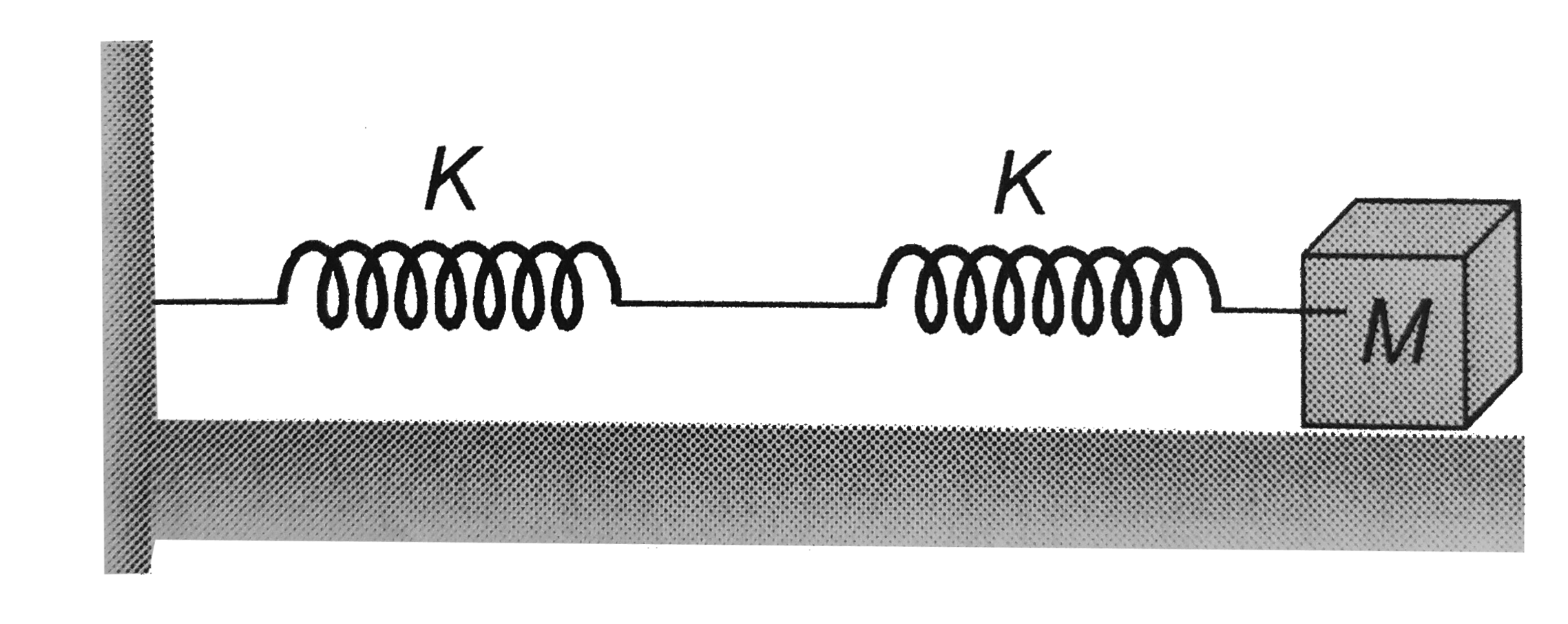Two masses m1andm2 are suspended together by a massless spring of constant k. When the masses are in equilibrium, m1 is removed without disturbing the system. Then the angular frequency of oscillation of m2 is
√(k/m1)
√(k/m2)
√[k(m1+m2)]
√[k/(m1m2)]
The correct Answer is:B
To solve the problem, we need to find the angular frequency of oscillation of mass m2 after mass m1 is removed from the system. Here are the steps to arrive at the solution:
Step 1: Understand the System
Initially, both masses m1 and m2 are suspended together by a massless spring with spring constant k. When both masses are present, they are in equilibrium under the influence of gravity.
Step 2: Remove Mass m1
When mass m1 is removed, only mass m2 remains suspended from the spring. The spring will now oscillate with mass m2.
Step 3: Identify the Angular Frequency Formula
The angular frequency ω of a mass-spring system is given by the formula:
ω=√kequivalentmequivalent
where kequivalent is the spring constant and mequivalent is the mass attached to the spring.
Step 4: Determine the Values
In this case:
- The spring constant kequivalent remains k (since the spring is unchanged).
- The mass mequivalent is now just m2 (since m1 has been removed).
Step 5: Substitute the Values into the Formula
Substituting the values into the angular frequency formula, we get:
ω=√km2
Step 6: Conclusion
Thus, the angular frequency of oscillation of mass m2 after mass m1 is removed is:
ω=√km2
Final Answer
The angular frequency of oscillation of m2 is √km2.
---
Initially, both masses m1 and m2 are suspended together by a massless spring with spring constant k. When both masses are present, they are in equilibrium under the influence of gravity.
When mass m1 is removed, only mass m2 remains suspended from the spring. The spring will now oscillate with mass m2.
The angular frequency ω of a mass-spring system is given by the formula:
ω=√kequivalentmequivalent
where kequivalent is the spring constant and mequivalent is the mass attached to the spring.
In this case:
- The spring constant kequivalent remains k (since the spring is unchanged).
- The mass mequivalent is now just m2 (since m1 has been removed).
Substituting the values into the angular frequency formula, we get:
ω=√km2
Thus, the angular frequency of oscillation of mass m2 after mass m1 is removed is:
ω=√km2
The angular frequency of oscillation of m2 is √km2.
Topper's Solved these Questions
- COMPETITION CARE UNITBOOK - ICSECHAPTER - COMPETITION CARE UNITEXERCISE - WAVES
98 Videos
- COMPETITION CARE UNITBOOK - ICSECHAPTER - COMPETITION CARE UNITEXERCISE - NDA EXAM QUESTIONS
55 Videos
- COMPETITION CARE UNITBOOK - ICSECHAPTER - COMPETITION CARE UNITEXERCISE - THERMAL RADIATION
13 Videos
- CIRCULAR MOTION BOOK - ICSECHAPTER - CIRCULAR MOTION EXERCISE - MODULE 2 (FROM ROTATIONAL KINETIC ENERGY , WORK ,POWER)
24 Videos
- DIMENSIONSBOOK - ICSECHAPTER - DIMENSIONSEXERCISE - SELECTED PROBLEMS (FROM CONVERSIONS OF ONE SYSTEMS OF UNITS INTO ANOTHER)
9 Videos
Similar Questions
Two masses m 1 and m 2 are suspended together by a massless spring of constant K . When the masses are in equilibrium, m 1 is removed without disturbing the system. The amplitude of oscillations is

View SolutionTwo masses M and m are suspended together by massless spring of force constant -k. When the masses are in equilibrium, M is removed without disturbing the system. The amplitude of oscillations.
View SolutionTwo masses m1=1kgandm2=0.5kg are suspended together by a massless spring of spring constant 12.5Nm−1. When masses are in equilibrium m1 is removed without disturbing the system. New amplitude of oscillation will be
View SolutionTwo masses 8 kg 4 kg are suspended together by a massless spring of spring constant 1000Nm−1 . When the masses are in equilibrium 8 kg is removed without disturbing the system . The amplitude of oscillation is
View SolutionTwo blocks of masses m1 and m2 are connected by a massless spring and placed on smooth surface. The spring initially stretched and released. Then :
View SolutionA block of mass m suspended from a spring of spring constant k. Find the amplitude of S.H.M.
View SolutionA block of mass m connected with a smooth prismatic wedge of mass M is released from rest when the spring is relaxed. Find the angular frequency of oscillation.

View SolutionThe two masses m1 and m2 are joined by a spring as shown. The system is dropped to the ground from a height. The spring will be

View SolutionTwo springs of force constants k1 and k2, are connected to a mass m as shown. The frequency of oscillation of the mass is f. If both k1 and k2 are made four times their original values, the frequency of oscillation becomes
_E01_383_Q01.png)
View SolutionTwo spring are connected toa block of mass M placed a frictionless surface as shown if both the spring have a spring constant k the frequency of oscillation block is

View Solution
